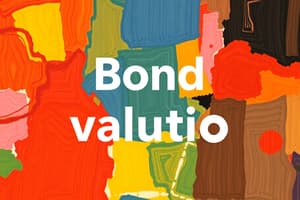Podcast
Questions and Answers
What is the primary risk associated with debentures compared to bonds?
What is the primary risk associated with debentures compared to bonds?
- Debentures have shorter terms to maturity.
- Debentures tend to offer higher coupon payments.
- Debentures are prone to interest rate fluctuations.
- Debentures are secured only by the corporation’s promise to pay. (correct)
If a bond has a par value of $1000 and a coupon rate of 5%, how much does it pay in coupon payments annually?
If a bond has a par value of $1000 and a coupon rate of 5%, how much does it pay in coupon payments annually?
- $60
- $50 (correct)
- $40
- $70
What does the term 'coupon payment' refer to in the context of bonds?
What does the term 'coupon payment' refer to in the context of bonds?
- The periodic interest income paid to bondholders. (correct)
- The difference between market price and par value.
- The total amount paid back at maturity.
- The initial investment made by the bondholder.
How is a bond's market price typically expressed?
How is a bond's market price typically expressed?
What happens to a bondholder at the bond's maturity?
What happens to a bondholder at the bond's maturity?
What is meant by the term 'term to maturity' in bonds?
What is meant by the term 'term to maturity' in bonds?
Why might an investor prefer bonds over bank deposits?
Why might an investor prefer bonds over bank deposits?
If a bond is selling for 95.21 percent of its par value of $1000, what is its selling price?
If a bond is selling for 95.21 percent of its par value of $1000, what is its selling price?
What does the liquidity preference theory suggest about long-term bonds?
What does the liquidity preference theory suggest about long-term bonds?
What does the upward slope of the yield curve typically indicate?
What does the upward slope of the yield curve typically indicate?
According to the market segmentation theory, what primarily determines the shape of the yield curve?
According to the market segmentation theory, what primarily determines the shape of the yield curve?
Which of the following best describes the pure expectations theory?
Which of the following best describes the pure expectations theory?
What is a common characteristic of an inverted yield curve?
What is a common characteristic of an inverted yield curve?
The yield for a one-year bond after one year is expected to be higher than the initial one-year bond rate if:
The yield for a one-year bond after one year is expected to be higher than the initial one-year bond rate if:
In the context of interest rates, what is the likely effect of high demand for long-term bonds?
In the context of interest rates, what is the likely effect of high demand for long-term bonds?
What is a proposed reason for increased yields on short-term debt securities?
What is a proposed reason for increased yields on short-term debt securities?
What is likely to happen to the principal, or face value, of a bond upon maturity?
What is likely to happen to the principal, or face value, of a bond upon maturity?
Which scenario would make bonds more appealing over stocks for an investor?
Which scenario would make bonds more appealing over stocks for an investor?
What is a callable bond?
What is a callable bond?
What does a sinking fund do?
What does a sinking fund do?
What allows an investor to convert a bond into shares of stock?
What allows an investor to convert a bond into shares of stock?
Why do callable bonds usually offer slightly higher returns?
Why do callable bonds usually offer slightly higher returns?
What is an advantage of owning extendible bonds?
What is an advantage of owning extendible bonds?
What typically happens in a company with a put feature on their bonds?
What typically happens in a company with a put feature on their bonds?
What is the effect of interest rate decreases on extendible bonds?
What is the effect of interest rate decreases on extendible bonds?
How is the total return from Abigail's bond calculated if she holds it to maturity?
How is the total return from Abigail's bond calculated if she holds it to maturity?
What is a primary reason investors might accept a lower return from convertible bonds?
What is a primary reason investors might accept a lower return from convertible bonds?
What is true regarding current yield?
What is true regarding current yield?
How is the semi-annual coupon payment calculated for Abigail's bond?
How is the semi-annual coupon payment calculated for Abigail's bond?
If interest rates decrease, what is a possible strategy for an investor holding a put option bond?
If interest rates decrease, what is a possible strategy for an investor holding a put option bond?
How is the current yield of a bond calculated?
How is the current yield of a bond calculated?
What happens to the yield to maturity (YTM) of a bond when it is sold at a price lower than its par value?
What happens to the yield to maturity (YTM) of a bond when it is sold at a price lower than its par value?
What is a characteristic of a discount bond?
What is a characteristic of a discount bond?
What is the yield to maturity (YTM) of a bond with a par value of $1000, a coupon rate of 6 percent, and a market price of $1000?
What is the yield to maturity (YTM) of a bond with a par value of $1000, a coupon rate of 6 percent, and a market price of $1000?
What does the yield to call (YTC) measure?
What does the yield to call (YTC) measure?
Which scenario results in a yield to maturity lower than the coupon rate?
Which scenario results in a yield to maturity lower than the coupon rate?
What does a normal yield curve represent?
What does a normal yield curve represent?
What is the yield to maturity of Courtney's bond which she purchased for $9000, has a coupon rate of 4%, and matures in 3 years?
What is the yield to maturity of Courtney's bond which she purchased for $9000, has a coupon rate of 4%, and matures in 3 years?
What factors can affect bond prices in the secondary market?
What factors can affect bond prices in the secondary market?
What is a characteristic of an inverted yield curve?
What is a characteristic of an inverted yield curve?
How often are coupon payments made for a bond with an annual payment structure?
How often are coupon payments made for a bond with an annual payment structure?
What does a steep yield curve indicate?
What does a steep yield curve indicate?
In what circumstance might an investor decide to sell bonds in the secondary market?
In what circumstance might an investor decide to sell bonds in the secondary market?
What is the relationship observed in the term structure of interest rates?
What is the relationship observed in the term structure of interest rates?
What is the primary reason for bonds to trade in the secondary market?
What is the primary reason for bonds to trade in the secondary market?
Flashcards
Bonds
Bonds
Long-term debt securities issued by government agencies or corporations, often collateralized by assets, offering potentially better returns than bank deposits.
Coupon Payment
Coupon Payment
A fixed percentage of the par value paid periodically to bondholders as interest income.
Par Value
Par Value
The face value of a bond, representing the amount returned to the investor at maturity.
Market Price (of a Bond)
Market Price (of a Bond)
Signup and view all the flashcards
Coupon Interest Rate
Coupon Interest Rate
Signup and view all the flashcards
Maturity Date
Maturity Date
Signup and view all the flashcards
Term to Maturity
Term to Maturity
Signup and view all the flashcards
Debentures
Debentures
Signup and view all the flashcards
Bond Principal
Bond Principal
Signup and view all the flashcards
Callable Bond
Callable Bond
Signup and view all the flashcards
Noncallable Bond
Noncallable Bond
Signup and view all the flashcards
Sinking Fund
Sinking Fund
Signup and view all the flashcards
Convertible Bond
Convertible Bond
Signup and view all the flashcards
Extendible Bond
Extendible Bond
Signup and view all the flashcards
Put Feature Bond
Put Feature Bond
Signup and view all the flashcards
Coupon Rate
Coupon Rate
Signup and view all the flashcards
Quoted Selling Price
Quoted Selling Price
Signup and view all the flashcards
Yield to Maturity
Yield to Maturity
Signup and view all the flashcards
Bond Refunding
Bond Refunding
Signup and view all the flashcards
Call Premium
Call Premium
Signup and view all the flashcards
Current Yield
Current Yield
Signup and view all the flashcards
Discount
Discount
Signup and view all the flashcards
Term Structure of Interest Rates
Term Structure of Interest Rates
Signup and view all the flashcards
Normal Yield Curve
Normal Yield Curve
Signup and view all the flashcards
Inverted Yield Curve
Inverted Yield Curve
Signup and view all the flashcards
Liquidity Preference Theory
Liquidity Preference Theory
Signup and view all the flashcards
Pure Expectations Theory
Pure Expectations Theory
Signup and view all the flashcards
Market Segmentation Theory
Market Segmentation Theory
Signup and view all the flashcards
Inverted Yield Curve and Economic Slowdown
Inverted Yield Curve and Economic Slowdown
Signup and view all the flashcards
Importance of Yield Curve
Importance of Yield Curve
Signup and view all the flashcards
Yield to Maturity (YTM)
Yield to Maturity (YTM)
Signup and view all the flashcards
Discount Bond
Discount Bond
Signup and view all the flashcards
Premium Bond
Premium Bond
Signup and view all the flashcards
Yield to Call (YTC)
Yield to Call (YTC)
Signup and view all the flashcards
Secondary Market
Secondary Market
Signup and view all the flashcards
Fixed-Rate Bond
Fixed-Rate Bond
Signup and view all the flashcards
Floating-Rate Bond
Floating-Rate Bond
Signup and view all the flashcards
Yield to Maturity (YTM)
Yield to Maturity (YTM)
Signup and view all the flashcards
Interest Rate
Interest Rate
Signup and view all the flashcards
Study Notes
Bond Fundamentals
- Bonds are long-term debt securities issued by governments or corporations, backed by assets. They often yield more than bank deposits.
- Bonds typically pay fixed, periodic interest (coupon) payments.
- Debentures are similar to bonds, but backed only by the issuer's promise to pay, making them riskier.
Bond Valuation
- Par value (face value) is the amount returned to the investor at maturity.
- Market price is expressed as a percentage of par value (e.g., 95.21 means 95.21% of $1000 par value = $952.10).
- Coupon rate is the annual interest rate as a percentage of par value (e.g., 6% on a $1000 bond = $60 annual interest). Payments are often semi-annual.
- Term to maturity is the time until the bond expires, when par value and any remaining coupons are returned. Maturities can range from 1 to 30 years.
Bond Returns and Investment Considerations
- Initial bond prices may be below par value, offering a return beyond coupon payments.
- Bonds are a good choice for investors seeking regular income.
- Investors often diversify portfolios with a mix of stocks and bonds.
Bond Features
-
Callable Bonds: Allow the issuer to buy back the bond before maturity, often at a higher price than the current market rate. An incentive for lower interest rates.
-
Sinking Fund: A mandatory repayment plan where the issuer sets aside funds to repurchase a specified amount of bonds over time. It's a mandatory and limited call provision.
-
Convertible Bonds: Can be exchanged for a set number of issuer shares at a fixed price. Higher potential return with stock price increases, potentially lower initial return.
-
Extendible Bonds: Allow investors to extend maturity dates when rates fall, potentially offering lower initial yields.
-
Put Bonds (Retractible Bonds): Allow investors to redeem at face value before maturity, if interest rates rise. Slightly lower initial return than without put option, protects investors from rising rates.
Bond Yield Measures
- Current Yield: Annual coupon payments divided by current market price.
- Yield to Maturity (YTM): Annualized return if held to maturity. If the bond trades at a discount to par, YTM > coupon rate. If the bond is trading at a premium to par, YTM < coupon rate.
TVM Calculations- Bond Value
- Time Value of Money (TVM) calculations are used to determine the yield to maturity given the bond details (present value, coupon payments, maturity).
Yield to Call (YTC)
- Yield to call measures return for callable bonds, until the call date, adjusted by call value.
Bond Trading
- Bonds are traded in a secondary market. If an investor needs funds, or if other securities are more appealing, they can sell their bonds in the secondary market.
- Prices change due to interest rate and other market factors.
Term Structure of Interest Rates
- Term structure (yield curve) plots bond yield to maturity against time to maturity.
- Provides insights into expected future interest rate movements.
- Inverted yield curves (short-term rates > long-term rates) may signal economic slowdown.
- Common shapes: Normal (upward-sloping), steep, flat.
Theories on Yield Curve Formation
- Liquidity Preference Theory: Investors require higher returns for bonds with longer maturities.
- Pure Expectations Theory: Curve reflects expected future interest rate changes.
- Market Segmentation Theory: Curve is driven by supply and demand for bonds in relevant market segments.
Studying That Suits You
Use AI to generate personalized quizzes and flashcards to suit your learning preferences.




